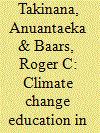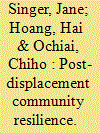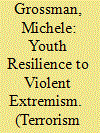|
|
|
Sort Order |
|
|
|
Items / Page
|
|
|
|
|
|
|
| Srl | Item |
| 1 |
ID:
191111


|
|
|
|
|
| Summary/Abstract |
Climate change education (CCE) can be an important tool to increase local community resilience. In 2017, the Pacific Community ratified the Framework for Resilient Development in the Pacific (FRDP) aiming to equip local communities with skills needed to become more climate change resilient. In 2018, Fiji implemented the Climate Change Resilience Programme (CCRP) at the University of the South Pacific (USP), the first of its kind in the South Pacific. This paper evaluates (i) the orientation and aim of the programme and (ii) how different stakeholders influenced the curriculum development process. Tribe's concept of curriculum space is used to highlight the overall aim of the CCRP. Freeman's stakeholder theory allows to identify key stakeholders and their influence on the curriculum. Results indicate that the programme seems to foster climate resilience in the workplace rather than the local community. Unfortunately, current and future community leaders, the notional targets of this course, were almost completely unrepresented in the process to accredit the course, with the body responsible for accreditation being dominated by industry representatives. This study helps to inform the current review of the Regional Certificate Programme to realign it with its initially envisioned community focus.
|
|
|
|
|
|
|
|
|
|
|
|
|
|
|
|
| 2 |
ID:
160939


|
|
|
|
|
| Summary/Abstract |
Conflicts in the post-heroic era present new challenges for the media. Rather than longer continuous reports in the national media, there are focused updates for residents in the conflict zone by means of local community media. This article examines the role played by local radio during a military conflict with post-heroic characteristics, focusing on a radio station broadcasting from the conflict zone close to the Gaza Strip during post-heroic military engagements from 2008 to 2014. The findings indicate a mix of resilience-promoting and resilience-impeding elements in presenters’ spontaneous discourse.
|
|
|
|
|
|
|
|
|
|
|
|
|
|
|
|
| 3 |
ID:
140238


|
|
|
|
|
| Summary/Abstract |
Despite an improving regulatory framework and policies governing compensation and resettlement, the majority of the millions displaced worldwide each year by hydropower dam construction continue to experience marginalisation and impoverishment, suggesting that external financial support must be supplemented by strengthened community-based resilience. In order to understand more about the innate resources of displaced rural communities, we applied a community resilience approach to two resettled Co-tu ethnic minority villages in an upland area in central Vietnam to identify their community capitals and their application in improving livelihoods and living conditions. We found that weak human and financial capital constrained the ability of the resettled residents to adopt new livelihoods or migrate to seek employment. Reduced forest and river access also problematised responses to a lack of agricultural land. However, traditionally strong village affinity and social networks were retained. In addition, indigenous skills such as housing construction, honed by a highly mobile traditional lifestyle, allowed residents to construct culturally significant structures like community houses and modify or augment received housing stock. These elements of social and cultural capital eased the process of post-resettlement adaptation. We conclude that governments should reassess current resettlement policies that prioritise financial compensation and should incorporate awareness of the adaptive resilience and limitations fostered by indigenous knowledge and practices in resettlement action plans.
|
|
|
|
|
|
|
|
|
|
|
|
|
|
|
|
| 4 |
ID:
169024


|
|
|
|
|
| Summary/Abstract |
Development policy and practice is replete with assumptions that local “communities” have both the willingness and capability to adapt to socio-environmental changes and become “resilient” to multiple old and new challenges. This paper analyzes socio-environmental change processes in a dynamic peri-urban context in the Kathmandu Valley of Nepal, and argues that unequal power relations between diverse actors and their differing interests refute notions of “collective action” and “community resilience.” Residents of peri-urban communities are diverse, have varying abilities and interests, and use different strategies and actions in response to complex socio-environmental changes. These differences reduce insecurities for some while reproducing inequalities for others. These interrelations at the local level are driven by wider socio-economic, political, and institutional processes that transcend community boundaries, interests, and benefits. In the face of these complexities, “community resilience” is an unviable, externally defined, and engineered goal, often at odds with the power discrepancies and heterogeneity found within actual communities. These findings suggest a need to pay attention to the social, economic, and political dynamics of socio-environmental changes that simultaneously shape local communities and their members’ abilities to respond to changes at various scales.
|
|
|
|
|
|
|
|
|
|
|
|
|
|
|
|
| 5 |
ID:
188040


|
|
|
|
|
| Summary/Abstract |
Building resilience to violent extremism has featured in preventing violent extremism efforts for over a decade. Validated and standardized cross-cultural measures can help identify protective capacities and vulnerabilities toward violent extremism for young people. Because drivers for violent extremism are multi-factorial, a measure of resilience cannot be used to predict who will and will not commit acts of terror. Instead, its purpose is to track the multiple forms of capital available to youth at risk of adopting violence to resolve ideological, religious and political grievances, and to use this data to inform interventions that increase young people’s capacity to resist violent extremism’s push and pull forces. In this study, we developed such a measure, using data from 200 Australian and 275 Canadian participants aged eighteen to thirty years old. Following exploratory and confirmatory factor analysis, a fourteen-item measure emerged consisting of five factors: cultural identity and connectedness; bridging capital; linking capital; violence-related behaviors, and violence-related beliefs. The Building Resilience against Violent Extremism (BRAVE) measure was found to have good internal reliability (α = .76), correlating in expected directions with related measures. The BRAVE shows promise for helping understand young people’s resilience to violent extremism.
|
|
|
|
|
|
|
|
|
|
|
|
|
|
|
|
|
|
|
|
|